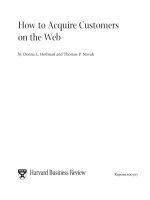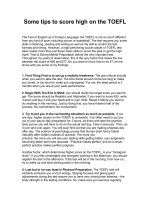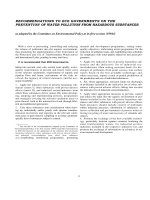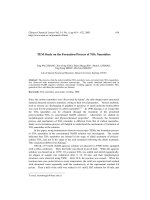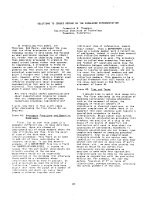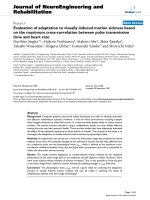EFFECT OF CARBON TO NITROGEN RATIO ON THE COMPOSTING OF CASSAVA PULP WITH SWINE MANURE
Bạn đang xem bản rút gọn của tài liệu. Xem và tải ngay bản đầy đủ của tài liệu tại đây (339.89 KB, 18 trang )
Journal of Water and Environment Technology, Vol.4, No.1, 2006
EFFECT OF CARBON TO NITROGEN RATIO
ON THE COMPOSTING OF CASSAVA PULP WITH
SWINE MANURE
Nattipong Kamolmanit*, and Alissara Reungsang**
*Department of Biotechnology, Graduate School, Khon Kaen University
A.Muang, Khon Kaen 40002 THAILAND
E-mail:
**Research Centre for Environmental and Hazardous Substance
Management and Department of Biotechnology, Faculty of Technology,
Khon Kaen University, A.Muang, Khon Kaen 40002 THAILAND
E-mail: ; Correspondence author
ABSTRACT
This research investigated the composting process of cassava pulp and swine manure at
various initial C/N ratios of 20/1, 30/1, and 40/1 and the effect of microbial activator, p.d.1,
on composting process. Compost with an initial C/N ratio of 30/1 seeded with p.d.1
showed the highest maximum temperature (63.5°C), the lowest number of faecal coliform
(2.87 Log10 MPN g-1), and the shortest time (around day 42) to reach maturity, suggesting
a suitable initial C/N ratio.
KEYWORDS: Cassava pulp, C/N ratio, Compost, Swine Manure
INTRODUCTION
Cassava (Manihot esculenta Crantz) is one of the most important crops in Thailand.
Approximately 40 percent of the cassava produced in Thailand is converted into starch.
Domestic demand for cassava starch is as high as 1.3-1.7 million tons per year (Thai
Tapioca starch Association, 2005). The cassava processing industry produces solid
residues known as “pulp”. Cassava pulp contains a large amount of carbohydrate (up to
50-60% dry weight basis), fiber and minerals such as Cu, Zn, Mn, Fe and Mg (Penuliar,
1940) and has a moisture content of about 60-70 % (Sriroth et al, 2000). Cassava pulp is
commonly used as organic soil amendment and bulking agent for composting. Some
researches focused on the utilization of cassava pulp as a single cell protein and as a raw
material for ethanol production (Boonyakamol, 2003; Potisung, 2003). However, since
cassava pulp has high carbon content, its value can be enhanced if mixed with other
organic waste of high nitrogen content and used as soil amendment.
Composting is a biological decomposition process, wherein organic matter is degraded to
achieve inorganic nutrients and stable organic material (compost) at the end. Composting
- 33 -
Journal of Water and Environment Technology, Vol.4, No.1, 2006
is generally used for the treatment of organic wastes such as sewage sludge and animal
manure. It is also used in agro-industrial process to obtain products which can be applied
to soil to increase soil organic matter content as well as enhance soil structure and cation
exchange capacity (Contreras-Ramos et al, 2004). During the decomposition process,
initial carbon to nitrogen ratio (C/N) in compost material is the major controllable factor
indicating the digestion process which include enzymatic activity by microorganisms
(Bertoldi et al, 1983). The C/N ratio can be used as an indicator for compost maturity.
The initial C/N ratio in compost affects the quality of mature products (Heerden et al,
2002; Huang et al, 2004). It is reported that an initial C/N ratio of 25-30 is suitable for
microbial activities during the nitrification process (Alexander, 1961).
Animal manure such as pig manure, spent pig manure, cow manure, and solid poultry
manure had been used for adjusting C/N levels in composting pile (Tiquia et al, 1996;
Guerra-Rodriguez et al., 2001; Contreras-Ramos, 2004; Huang et al, 2004). Swine
manure is one promising N-source because it contains 70 % water, 36.6 % total organic
carbon, 3.24 % total nitrogen and 1.72 % total phosphorus (Tiquia and Tam, 1998; Huang
et al, 2004). Furthermore, the pH and C/N ratio of swine manure are 8.12 and 11.3,
respectively, (Huang et al, 2004) which makes it suitable as supplement for C/N ratio
adjustment in composting.
Composting process can be accelerated through the addition of microbial activators such
as LD-1, F-60, Bionic, and p.d.1 (Subjarearn et al, 2002). A commercial microbial product
is often added to the compost mixture to ensure the establishment of initial microbial
population and enhance the composting process (Tiquia et al, 1997a; Subjarearn et al,
2002). The commercial bacterial product that has been used to enhance the composting
process in Thailand is a microbial activator p.d.1 (Subjarearn et al, 2002). The p.d.1
consists of various degrading lignocellulolytic microorganisms such as bacteria,
actinomycetes and fungi that can accelerate the decomposition rate when seeded to the
compost (Land Development Department, 2003). Cassava pulp and swine manure
composting processes with and without p.d.1 and the quality of the final compost products
are worth investigated. Several studies reported the use of animal manure compost for
plant production in agricultural farm due to its low cost as compared to inorganic
fertilisers (Stephanon et al., 1990; Gajalakshini and Abbasi, 2002; Ta-oun, 2003).
However, there is a very limited information on the use of cassava pulp as raw material in
composting process. Thus, in this study, cassava pulp and swine manure were used as raw
materials for compost production with and without microbial activator (p.d.1).
- 34 -
Journal of Water and Environment Technology, Vol.4, No.1, 2006
MATERIALS AND METHODS
Raw materials
Cassava pulp
Cassava pulp was collected from Takul Lek Tapioca Flour Factory Co., Ltd.
Mahasarakham, Thailand. The pulp was air-dried for 3 weeks prior to usage.
Swine manure
Swine manure (a mixture of liquid and solid forms) was obtained from the pig farm
located at the Faculty of Agriculture, Khon Kaen University, Khon Kaen, Thailand. Subsamples of swine manure were air dried at 80 °C for 24 h, ground and passed through a 2.0
mm sieve. The samples were then stored in desiccator for further analysis and usage.
p.d. 1
Microbial activator (p.d.1) was obtained from the Land Development Department, Khon
Kaen, Thailand. The p.d.1 consists of 2 strains of bacteria in Genus Bacillus sp., 2 strains
of Actinomyces in Genus Streptomyces sp., and 4 strains of fungi that include
Scopulariopsis sp., Helicomyces sp., Chaetomium sp., and Trichoderma sp.
(Sunanthapongsuk, 2001). These commercial microbial products are often added to the
compost mixture to enhance the composting process in Thailand (Subjarearn et al,
2002;Land Development Department, 2003).
Composting pile establishment
The first set of composting piles was prepared as follows :
Pile 1: Cassava pulp and swine manure at an initial C:N ratio of 20:1 (dw/dw)
Pile 2: Cassava pulp and swine manure at an initial C:N ratio of 30:1 (dw/dw)
Pile 3: Cassava pulp and swine manure at an initial C:N ratio of 40:1 (dw/dw)
Each pile contained 20 kg of mixture. The dimension of each pile was approximately 50
cm (width) X 50 cm (length) X 50 cm (height). Every seven days, the moisture content in
each pile was adjusted to 60 % before and during the composting process until the
temperature in compost reached the ambient temperature.
The second set of composting piles (pile 4, pile 5 and pile 6) was prepared in a similar
manner as the first set but the seeding microbial activator (p.d.1) was added to each pile in
a p.d.1/composting pile ratio of 10 ml:500 g of compost. Every seven days, the moisture
content of the mixture was also adjusted to 60% through the addition of water before and
during the composting process. When the temperature in compost piles reached the
ambient temperature, addition of water was stopped although the composting process
- 35 -
Journal of Water and Environment Technology, Vol.4, No.1, 2006
continued. Each compost pile was manually mixed with a shovel for about 10 minutes to
turn the pile and provide aeration. This was done every 3-4 days until the compost piles
reached maturity. The ambient temperature and the temperature within each pile at a depth
of 15 cm from the surface of the piles were determined using a thermometer. At days 14,
28, 42, 56, 70 and 84, after turning the compost piles, a 50 g sub-sample was randomly
collected from the compost pile and analyzed using some physical and biological
parameters (Table 1).
Table 1 Physicochemical and biological parameters used for analyses of samples.
Parameter
pH
Method
pH meter
Sampling date
Every 3-4 day
Temperature
Thermometer
Everyday
Moisture content (%)
Total organic carbon (%)
Oven dry method
Walkley and Black method
Every 7 day
Every 14 day
Total Nitrogen (%)
Micro-kjeldahl method
Every 14 day
Reference
Tiquia and Tam
(1998)
Tiquia and Tam
(1998)
Page et al (1982)
Walkley and
Black (1934)
Black (1965)
Total Phosphorus (%)
Spectrophotometric method
Every 14 day
Black (1965)
Total Potassium (%)
Atomic absorption technique
method
Most Probable Number
Every 14 day
Black (1965)
Every 14 day
AOAC (2000)
Faecal coliforms
Statistical analysis
Mean and standard deviation values were reported for all parameters measured. Analysis
of variance (ANOVA) and Duncan’ s multiple range test were performed using SPSS v.
11 statistical software for windows. One-way ANOVA was carried out to compare the
means of different treatments where significant F-values at p≤ 0.05 were obtained.
Differences between individual means were tested using the least significant difference
test.
- 36 -
Journal of Water and Environment Technology, Vol.4, No.1, 2006
RESULTS AND DISCUSSION
Main characteristics of cassava pulp and swine manure.
Analysis of cassava pulp revealed that it had high carbon content but low nitrogen thus
giving a high C/N ratio (Table 2). The pH of cassava pulp indicated that it was slightly
acidic.
Although the carbon content of swine manure was twice as low as that of cassava pulp, its
nitrogen content was about five times higher. This caused the C/N ratio of the former to
be 10 times higher than that of the latter (Table 2) indicating that swine manure was
suitable for the adjustment of C/N ratio in composting.
Table 2 Main characteristics of the raw materials.
Parameters
pH
Moisture content (%)
Total organic carbon (%)
Total Nitrogen (%)
Total Phosphorus (%)
Total Potassium (%)
C/N ratio
‡
Cassava pulp
5.81 ± 0.05‡
9.36 ± 0.11
51.51 ± 1.25
0.45 ± 0.09
0.011 ± 0.002
0.36 ± 0.01
118.34 ± 22.78
Swine manure
8.21 ± 0.02
16.89 ± 0.2
26.16 ± 0.09
2.47 ± 0.22
6.42 ± 0.06
1.42 ± 0.26
10.66 ± 0.89
Mean ± standard deviation.
Compost characteristics
Temperature profile
The initial mean temperature of all piles was approximately 25 °C. A high temperature of
63.5°C was found in Pile 5 at Day 4. High temperature continued to be observed in this
pile for about 24 days (Figure 1) and then gradually dropped to 30.5 °C at Day 40. After
day 40, the temperature varied within a narrow range until day 84 (Figure 1).
The other piles showed a similar pattern of temperature changes as in pile 5 except that the
maximum temperatures recorded in piles 3 and 6 were lower (≈59 °C) as shown in Figure
1. The pattern of these temperatures i.e., increase to a certain temperature, remain constant
at that temperature and then decrease was a typical temperature profile of composting
process especially for cow manure and wheat straw composts (Tiquia and Tam, 1998),
citrus wastes compost (Heerden et al, 2002), spent pig manure and sawdust litter composts
(Huang et al, 2004) and filter cake and bagasse composts (Meunchang et al, 2005). The
levels of temperature in the compost piles increased and reached 50-60°C due to the
energy released from biochemical reaction of microorganisms in the compost piles while
- 37 -
Journal of Water and Environment Technology, Vol.4, No.1, 2006
the temperature in compost piles tend to decrease after the thermophilic phase due to the
loss of substrate and a decrease in microbial activity (Bertoldi et al., 1983)
The level of temperature in compost piles can be used as an indicator of compost maturity
(Tiquia et al, 1997a; Tiquia et al, 1997b). Tiquia et al (1997a, 1997b) reported that a
compost material could be considered mature when the temperature in the compost
reached the ambient temperature. With this, the compost in pile 5 was considered matured
after day 40, which was the fastest among the piles.
C /N ,
C /N ,
C /N ,
C /N ,
C /N ,
C /N ,
Temperature (c)
60
2 0 /1
3 0 /1
4 0 /1
2 0 /1
3 0 /1
4 0 /1
n o s e e d in g ( p ile 1 )
n o s e e d in g ( p ile 2 )
n o s e e d in g ( p ile 3 )
s e e d in g p .d .1 ( p ile 4 )
s e e d in g p .d .1 ( p ile 5 )
s e e d in g p .d .1 ( p ile 6 )
40
20
0
0
7
14
21
28
35
42
49
56
63
70
77
84
composting time (day)
Figure 1 Temperature profiles during composting of cassava pulp with swine manure
Changes in pH
During the composting process, the pH of all piles dropped from approximately 7.8 to 5.5
during the first 18 days of composting (Figure 2). The pH of compost in piles 3 and 6 were
lower than the other piles. This may be due to the higher organic carbon content (around
45%) in these piles. A large pH drop in the compost piles at the initial stage of composting
might be due to the fact that organic carbon was degraded to organic acid by the acidforming bacteria existing in the compost pile (FAO, 1987). In addition, the pH drop might
be caused by the mineralization of organic acid during the composting process as well as
the large quantities of carbon dioxide released during the composting process (FAO,
1987; Tiquia et al, 1996; Tiquia et al, 1997a; Tiquia and Tam, 1998; Huang et al, 2004;
Meunchang et al, 2005).
- 38 -
Journal of Water and Environment Technology, Vol.4, No.1, 2006
9
8
pH
7
6
C/N,
C/N,
C/N,
C/N,
C/N,
C/N,
5
0
7
14
21
28
35
42
49
56
20/1
30/1
40/1
20/1
30/1
40/1
no seeding ( pile 1 )
no seeding ( pile 2 )
no seeding ( pile 3 )
seeding p.d.1 ( pile 4 )
seeding p.d.1 ( pile 5 )
seeding p.d.1 ( pile 6 )
63
70
77
84
Com posting tim e, days
Figure 2 Changes in pH during composting of cassava pulp with swine manure.
After 18 days of composting, the pH of all piles increased and pH levels remained
relatively unchanged after Day 35. The increase of pH in composting piles during the
composting process could be due to the production of ammonium as a result of the
ammonification process (Huang et al., 2004). The pH patterns were concomitant to the
previous studies on the composting of other organic wastes (Meunchang et al, 2005;
Tiquia and Tam, 1998). Tiquia and Tam (2002) studied the changes on composting of
spent pig manure and sawdust litter. They reported that the changes in temperature of
composting had a strong correlation with some chemical parameters such as the pH and
decided to use these parameters to determine the maturity of compost.
Moisture content
Moisture content at Day 0 and during the composting process in all compost piles were
adjusted to 60 % because an optimum level of moisture content had strong effect on
oxygen consumption rate of aerobic heterotroph microorganisms (Tiquia et al, 1996). It
was reported that a suitable and efficient moisture content in composting of spent litter
was between 50 % and 60 %.
At the initial stage of composting, the moisture content of all piles was around 62-64% and
dropped gradually during composting time (Figure 3). When the temperature in the
compost piles reached the ambient temperature, addition of water was stopped although
the composting process continued. Afterwards, the moisture content of all piles decreased
slowly to around 38.82-46.62 % at the end of the composting period. It was considered
that the piles have achieved an acceptable level of quality of mature compost, i.e., ≤50%
(Ta-oun et al., 2005). A decrease in moisture content was due to the release of moisture
- 39 -
Journal of Water and Environment Technology, Vol.4, No.1, 2006
from the compost pile through water evaporation as a result of the heat generated from
microbial activities during composting (Miller and Finstein, 1985).
C/N
C/N
C/N
C/N
C/N
C/N
Moisture content (percent)
80
70
20/1
30/1
40/1
20/1
30/1
40/1
no seeding ( pile 1 )
no seeding ( pile 2 )
no seeding ( pile 3 )
seeding ( pile 4 )
seeding ( pile 5 )
seeding ( pile 6 )
60
50
40
30
20
0
7
14
21
28
35
42
49
56
63
70
77
84
Composting time (day)
Figure 3 Changes in moisture content during composting of cassava pulp with swine
manure.
Total organic carbon and total nitrogen
During the composting process, total organic carbon in all piles sharply decreased in the
first 28 days of composting and from 33 - 45% initial carbon content, it dropped to nearly
25% at the end of the composting period (Figure 4). Decrease in total organic carbon
concentration resulted from the oxidation of carbon to carbon dioxide by microorganisms
during composting (Tiquia et al., 1996).
Throughout the composting process, total organic carbon loss in pile 1 (24.28%) and pile 4
(16.85%) was lower than those of the other piles (32% in pile 2, 39.44% in pile 3, 39.43%
in pile 5 and 39.74% in pile 6). The small decrease in total organic carbon in pile 1 and
pile 4 could have resulted from a poor decomposition when the initial C/N ratio was low
(Huang et al., 2004). In addition, recalcitrant organic wastes such as cellulose and lignin
may affect a degree of organic carbon loss during the decomposition process (Huang et al,
2004).
Total organic carbon in pile 3 and pile 6 was higher than those of the other piles in the first
70 days due to a larger amount of organic carbon supplied in these 2 piles, specifically,
large amount of cassava pulp was added into the compost mixture prior to the composting
process.
- 40 -
Journal of Water and Environment Technology, Vol.4, No.1, 2006
50
C/N,
C/N,
C/N,
C/N,
C/N,
C/N,
Total Organic Carbon (%)
45
20/1
30/1
40/1
20/1
30/1
40/1
no seeding ( pile 1 )
no seeding ( pile 2 )
no seeding ( pile 3 )
seeding p.d.1 ( pile 4 )
seeding p.d.1 ( pile 5 )
seeding p.d.1 ( pile 6 )
40
35
30
25
20
0
14
28
42
56
70
84
Composting time, days
Figure 4 Changes in total organic carbon during composting of cassava pulp with swine
manure.
Total nitrogen increased slightly in all composting piles (Figure 5). The increase in total
nitrogen during the composting process might be due to the activity of nitrogen fixing
bacteria which was expected to exist in the compost pile. These bacteria have the
capability to fix N2 from the air to NO3 contained in the pile (Bishop and Godfrey, 1983).
Huang et al. (2004) found the same results where the nitrogen content in the compost
slightly increased after 63 days of composting.
At the end of composting, piles 1, 2, 4 and 5 contained higher total nitrogen content
(2.33%, 2.19%, 2.46% and 2.11%, respectively) than pile 3 and 6 (1.72 % and 1.89 %,
respectively). The nitrogen in the compost pile mainly came from the swine manure added.
Thus, the nitrogen content in pile 1, 2, 4 and 5 (where larger amount of swine manure was
added) was found to be higher than in pile 3 and 6 at the end of composting.
- 41 -
Journal of Water and Environment Technology, Vol.4, No.1, 2006
5
C /N ,
C /N ,
C /N ,
C /N ,
C /N ,
C /N ,
Total Nitrogen (%)
4
20/1
30/1
40/1
20/1
30/1
40/1
no seeding ( pile 1 )
no seeding ( pile 2 )
no seeding ( pile 3 )
seeding p.d.1 ( pile 4 )
seeding p.d.1 ( pile 5 )
seeding p.d.1 ( pile 6 )
3
2
1
0
0
14
28
42
56
70
84
C om posting tim e, days
Figure 5 Changes in total nitrogen during composting of cassava pulp with swine manure.
Changes in total phosphorus and total potassium
The changes of total P and K followed a similar trend as total nitrogen wherein there was a
gradual increase throughout the composting period. Increase in total P and K may be due
to the net loss of dry mass which generally concentrated the phosphorus and potassium in
composting pile (Huang et al, 2004). In addition, Tiquia and Tam (2002) explained that
an increase in P and K during composting of poultry litter in forced-aeration piles were
due to losses of organic C, H, N, and O from composting piles as CO2 and H2O.
At day 84 of composting, as seen in Figure 6, total P in pile 1, 2, 4 and 5 were 2.51 %,
2.44 %, 2.52 % and 2.56 %, respectively, and were higher than pile 3 and pile 6 (1.61%
and 1.97 %, respectively). The amount of swine manure added to piles 3 and 6 was lower
than those added into pile 1 and pile 2 which could have resulted to a lower amount of
total phosphorous detected in these compost piles since the phosphorous detected in the
compost was mainly released from swine manure.
- 42 -
Journal of Water and Environment Technology, Vol.4, No.1, 2006
4
C/N,
C/N,
C/N,
C/N,
C/N,
C/N,
Total Phosphorus (%)
3
20/1
30/1
40/1
20/1
30/1
40/1
no seeding ( pile 1 )
no seeding ( pile 2 )
no seeding ( pile 3 )
seeding p.d.1 ( pile 4 )
seeding p.d.1 ( pile 5 )
seeding p.d.1 ( pile 6 )
2
1
0
0
14
28
42
56
70
84
Composting time, days
Figure 6 Changes in total phosphorus during composting of cassava pulp with swine
manure.
Total K in every pile slightly increased during the decomposition process (Figure 7). Total
potassium in pile 1, 2, 4, and 5 were 2.03 %, 1.89 %, 2.1 % and 1.97 %, respectively. At
the first day of composting, total K in pile 3 and 6 were lower than those of the other piles
may be due to the lower amount of swine manure added to these piles to obtain higher
initial C/N. At the end of composting, the percentage of total K in pile 3 and pile 6 were
also lower than those of the other piles (1.41 % and 1.58 %, respectively) indicating that
the percentage of K depended on the amount of swine manure added into the compost
piles.
Total K content in all piles were above the minimum acceptable level (K2O ≥ 0.5%)
according to the qualifications of mature compost recommended by Land Development
Department (2003). This suggested that cassava pulp and swine manure could be
effectively used for composting and would result to satisfactory composts in terms of
potassium content.
- 43 -
Journal of Water and Environment Technology, Vol.4, No.1, 2006
4
C/N, 20/1 no seeding ( pile 1 )
C/N, 30/1 no seeding ( pile 2 )
C/N 40/1 no seeding ( pile 3 )
C/N, 20/1 seeding p.d.1 ( pile 4 )
C/N, 30/1 seeding p.d.1 ( pile 5 )
C/N 40/1 seeding p.d.1 ( pile 6 )
Total Potassium (%)
3
2
1
0
0
14
28
42
56
70
84
Composting time, days
Figure 7 Changes in total potassium during composting of cassava pulp with swine
manure.
Changes in C/N ratio
The C/N ratio is one of the factors used to indicate compost maturation. A C/N ratio of 20
or less is accepted as mature compost (Land Development Department, 2003). The C/N
ratios of all piles in this study decreased, with the increase in composting time, to
approximately 15 at the end of composting (Day 84) indicating that the compost reached
maturity (Figure 8). Reports on the C/N ratio of compost at a maturity phase stated 13.27
for the co-composting of chestnut burr and leaves with solid poultry manure (GuerraRodriguez et al., 2001) and 11-17 for the composting of bagasse with sewage sludge
(Negro et al., 1999).
Percent loss of C/N ratio in pile 2, 3, 5 and 6 were 59.72 %, 62 %, 62.5 % and 64.9,
respectively, which were slightly higher than piles 1 and 4 (48.28 % and 46.31 %,
respectively). Lower percentage loss in pile 1 and 4 indicated that decomposition was poor
when the initial C/N ratio was low.
There was no difference in the changes of C/N ratio in the compost pile with the same
initial C/N ratio with or without p.d. 1 (Figure 8). These results indicated that p.d.1 did not
play an important role in the decomposition process of the composting piles in this study.
The initial C/N ratio was the main factor affecting the time to reach maturity of the
compost suggesting that it was not necessary to add the microorganisms as activator for
composting. Our results were supported by the work of Tiquia et al (1997b) who studied
- 44 -
Journal of Water and Environment Technology, Vol.4, No.1, 2006
the role of various commercial bacterial products during the composting of pig waste.
They discovered that an addition of the commercial bacterial product during the
composting process with moisture adjustment in windrow composting was not important.
If moisture content was adjusted, addition of bacterial product during composting would
not be needed.
50
C/N, 20/1 no seeding ( pile 1 )
C/N, 30/1 no seeding ( pile 2 )
C/N, 40/1 no seeding ( pile 3 )
C/N, 20/1 seeding p.d.1 ( pile 4 )
C/N, 30/1 seeding p.d.1 ( pile 5 )
C/N, 40/1 seeding p.d.1 ( pile 6 )
C/N ratio
40
30
20
10
0
0
14
28
42
56
70
84
Composting time, days
Figure 8 Changes in C/N ratio during composting of cassava pulp with swine manure.
Faecal coliforms elimination
Faecal coliforms are used as indicator organism for the maturity of compost. The survival
of faecal coliforms depends on environmental factors including pH, temperature, moisture
content, sunlight and nutrients (USEPA, 1995). Yanko et al (1987) reported that the faecal
coliforms could grow after thermophilic phase of the sewage sludge composting if they
were poorly composted and nutrient resource still remained. The USEPA recommended
that faecal coliforms should be less than 3.00 Log10 MPN g-1 in compost pile when it
reached maturity (USEPA, 1995). Tiquia et al (1998) reported that the numbers of faecal
coliforms were reduced to 2.27 Log10 MPN g-1 at a final date of spent pig litter composting.
At the beginning of our composting, the faecal coliforms were in the range of 5.07 – 7.09
Log10 MPN g-1 in all piles (Table 3). The faecal coliform numbers in pile 3 and 6 reduced
slightly over time and may be due to the fact that these two piles had lower maximum
temperature and slower rise in temperature (Figure 1) than other piles. USEPA (1995)
stated that a temperature higher than 40°C, for 5 days, was sufficient to reduce pathogens.
- 45 -
Journal of Water and Environment Technology, Vol.4, No.1, 2006
However, when piles 1, 2, 3, 4 and 6 reached maturity, although the numbers of faecal
coliform were reduced to around 3.11 -3.96 Log10 MPN g-1, these were still slightly higher
than the USEPA limits. Throughout the composting time, the faecal coliform numbers of
pile 5 reached 2.87 Log10 MPN g-1 at day 42 and were found to be less than those of the
other piles. This value was lower than the USEPA limit (Table 3). In addition, the final
composts obtained were of pleasant earthy smell and dark brown in color indicating a
good compost appearance.
Table 3 Changes in the number of faecal coliforms during composting of cassava pulp
with swine manure.
Faecal coliform numbers (Log 10 MPN g-1)
Time
(days)
Type of composting
Without seeding p.d. 1
Seeding with p.d. 1
20/1
‡
0
14
28
42
56
70
84
30/1
40/1
20/1
30/1
40/1
Pile1
6.04±0.43‡
3.63±0.45
3.68±0.39
3.31±0.50
3.26±0.36
ND
ND
Pile 2
6.76±0.5
4.54±0.53
4.14±0.26
3.5±1.19
3.14±0.19
ND
ND
Pile 3
5.09±0.43
7.22±0.62
6.03±0.86
5.33±0.72
5.02±0.81
3.96±0.74
ND
Pile 4
6.36±0.15
4.31±1.16
3.61±0.34
3.28±0.59
3.11±0.14
ND
ND
Pile 5
7.09±0.65
3.59±0.22
3.26±0.20
2.87±0.28
ND
ND
ND
Pile 6
5.67±0.73
6.93±0.51
6.31±0.84
6.04±0.16
4.44±0.48
3.78±0.72
ND
Mean ± standard deviation.ND-not determined as the piles had already reached maturity.
Main characteristics of final composts in all piles are shown in Table 4. The main
characteristics showed that the moisture content, total organic carbon, total nitrogen, pH,
total phosphorus, and total potassium in all final compost products were in acceptable
values according to Land Development Department (2003) indicating the high efficiency
of final compost. However, when considering the changes in temperature and faecal
coliform elimination, the results suggested that the compost in pile 5 (C/N, 30/1 with
seeding p.d.1) was the finest compost. This was due to the lowest number of faecal
coliform (2.87 Log10 MPN g-1) presented in this pile suggesting the highest degree of
sanitation compared to the other piles. USEPA (1995) stated that the number of faecal
coliform in final compost should not be greater than 3.00 Log10 MPN g-1 for sanitary use
of the compost. In addition, the compost in pile 5 reached maturity in a shorter time
(around day 42) compared to others. Therefore, the final compost from pile 5 (C/N ratio of
30/1 with a seeding of p.d.1) was considered as the most suitable compost to be used as
soil conditioner to enhance soil chemical properties, nutrient accumulation in plants and
plant growth.
- 46 -
Journal of Water and Environment Technology, Vol.4, No.1, 2006
Table 4 Main characteristics of final composts.
Compost characteristics
Parameter
Moisture (%)
Organic carbon (%)
Total Nitrogen (%)
C/N ratio
pH
Total Phosphorus (%)
Total Potassium (%)
Final Day Temperature (°C)
Coliform Numbers (Log10
MPN g-1)/day reach maturity
Without seeding
C/N
20/1
(Pile1)
41.78±
1.03ab‡*
24.72±
1.33a
2.33±
0.08ab
10.85±
0.17a
7.49±
0.34a
2.51±
0.16a
2.03±
0.09a
30.23±
0.25a
3.26±
0.36ab
/56
C/N
30/1
(Pile 2)
41.39±
1.71ab
26.34±
1.01ab
2.19±
0.50ab
11.99±
0.39a
7.46±
0.80a
2.44±
0.34a
1.89±
0.18a
29.83±
0.70ab
3.14±
0.18ab
/56
C/N
40/1
(Pile 3)
48.62±
2.00c
27.16±
0.60a
1.72±
0.35d
15.81±
0.66b
7.45±
0.36a
1.61±
0.06b
1.41±
0.13b
36.23±
0.91b
3.96±
0.73b
/70
Seeding with PD-1
C/N
20/1
(Pile 4)
38.92±
3.61a
26.89±
1.05a
2.46±
0.08a
11.07±
0.40a
7.9±
0.14b
2.52±
0.86a
2.10±
0.20a
29.0±
0.56ab
3.11±
0.14ab
/56
C/N
30/1
(Pile 5)
38.82±
4.30a
25.05±
0.38a
2.11±
0.14bc
11.91±
0.99a
7.39±
0.57a
2.56±
0.29a
1.97±
0.08a
28.83±
1.53ab
2.87±
0.27a
/42
C/N
40/1
(Pile 6)
46.15±
2.05bc
27.05±
0.80a
1.89±
0.31cd
14.62±
2.60b
7.46±
0.15a
1.97±
0.26b
1.58±
0.89b
34.87±
0.45b
3.78±
0.72b
/70
*
Means followed by the same letter within similar row are not significantly different using
Duncan’ s multiple range test at 0.05 level of significance.
‡
Mean ± standard deviation.
CONCLUSIONS
The conclusions drawn from the study are as follows:
1) Compost with an initial C/N ratio of 30/1 (cassava pulp/swine manure) seeded with
p.d.1 was the most satisfactory compost among the others due to a short time required to
reach maturity (around day 42) and low faecal coliform number (2.87 Log10 MPN g-1).
2) The p.d.1 did not play an important role in the decomposition process of the composting
piles. The initial C/N ratio was the main factor affecting the time to reach maturity of the
compost suggesting that it was not necessary to add an activator for composting.
- 47 -
Journal of Water and Environment Technology, Vol.4, No.1, 2006
ACKNOWLEDGMENTS
The authors would like to thank the TRF Master Research Grants: TRF-MAG (Grant
number: MRG475S039) for financial support in this research as well as the Graduate
School of Khon Kaen University, Thailand.
REFERENCES
Alexander M. (1961). Introduction to soil microbiology. Toppan Company, Tokyo.
AOAC (Official Methods of Analysis of AOAC International) (2000). 17th edn, William
Horvitz, USA.
Bertoldi, M., Vallini, G., Pera,A. (1983). The biology of composting : A Review., Waste
Manage. Res., Vol 1, 157-176.
Bishop, P.L., Godfrey, C. (1983). Nitrogen transformation during sludge
composting., Biocycle, Vol.24, 34-39.
Black, C.A. (1965). Method of soil analysis. Part II. American Society of
Agronomy Inc. Madison, Wisconsin, U.S.A.
Boonyakamol, A. (2003). Single cell proteins production from cassava pulp
Schwaniomyces accidectalis TISTR 5555 and the possibility of the yeast strain
improvement by intergeneric protoplast fusion technique. MSc Thesis,
Department of Biotechnology, Khon Kaen University.
Contreras-Ramos, S.M., Alvarez-Bernal, D., Trujillo-Tapia, N., Dendooven, L. (2004).
Composting of tannery effluent with cow manure and wheat straw., Biores.
Technol., Vol.94, 223-228.
FAO (FAO and Agriculture Organization of the United Nations). (1987). Soil
management:Compost production and use in tropical and subtropical
environments. FAO and Agriculture organization of the United Nations, pp. 177.
Guerra-Rodriguez, E., Diaz-Ravina, M., Vazquez, M. (2001).Co-composting of Chestnut
burr and leaf litter with solid poultry manure., Biores. Technol., Vol.78, 107-109.
Heerden, I.V., Cronje, C., Swart, S.H., Kotze, J.M. (2002). Microbial, chemical and
physical of citrus wastes composting., Biores. Technol., Vol.81, 71-76.
Huang, G.F., Wong, J.W.C., Wu, Q.T., Nagar, B.B. (2004). Effect of C/N on Composting
of pig manure with sawdust., Waste Manage. Res., Vol.24, 805-813.
Land Development Department. (2003). Microbial activator [online] [cited 10 March
2005]. Available from . [in Thai].
Meunchang, S., Panichsakpatana, S., Weaver, R.W.(2005). Co-composting of filter cake
and bagasse ; by-products from a sugar mill., Biores. Technol., Vol.96, 437-442.
Miller, F.C., Finstein, M.S.(1985). Material balance in the compositng of wastewater
sludge as affected by process control., J. Water Pollut. Control Fed., Vol. 57, 122127.
Negro, M.J., Salano, M.L., Ciria, P., Carrasco, J. (1999). Composting of sweet sorghum
bagasse with other wastes., Biores. Technol., Vol. 67, 89-92.
- 48 -
Journal of Water and Environment Technology, Vol.4, No.1, 2006
Page A.L., Miller R.H., Keeney D.R. (1982). Method of soil analysis: Part 2.
Chemical and microbiological properties. 2 nd edn, SSSA Public, Madison,
USA.
Penuliar, S.P. (1940). A comparative study of cassava refuse meal and rice bran as feeds
for growing and fattening pigs., Phil. Agricult., Vol. 29, 611-615.
Potisung, M.(2003). Ethanol production from cassava pulp hydrolysate by
Zymomonas mobilis. MSc thesis, Department of Biotechnology, Khon
Kaen University.
Sriroth, K., Chollakup, R., Chotineeranat, S., Piyachomkwan, K., Oates, C.G. (2000).
Processing of cassava waste for improved biomass utilization., Biores. Technol.,
Vol.71, 63-69.
Subjarearn, N., Navanugraha, C., Limtong, P., Mairiang, S., Sungpetch, A. (2002).
The efficiency of some microbial activators in organic composting from
market waste [on line]. [Cited 2005 April 4]. Available from:
WebCor47/ Aful/F059.pdf
Sunanthapongsuk, V. (2001). Production and utilization of cellulolytic microbial
activator for composting [on line]. [Cited 2005 April 4]. Available from:
http:// www. ldd. go.th/ORDweb/ORD-WebCor47/Aful/ F059.pdf.
Ta-oun, M., Prathumrung, P., Prathumrung, T. (2005). Techniques to produce bio-extracts
and compost fertilizers from domestic rubbish. Department of Land Resources and
Environment, Khon Kaen University. [in thai].
Thai Tapioca Starch Association. (2005). Manufacturing Process Development in Thai
Cassava Starch Industry [online]. [cited 2005 Feb 17]. Available from:
.
Tiquia, S.M., Tam, N.F.Y., Hodgkiss, I.J. (1996). Microbial activities during composting of
spent pig-manure sawdust litter at different moisture contents., Biores. Technol.,
Vol.55, 201-206.
Tiquia, S.M., Tam, N.F.Y., Hodgkiss, I.J. (1997a) Effect of turning frequency on
composting of spent pig-manure sawdust litter., Biores. Technol., Vol.62, 37-42.
Tiquia, S.M., Tam, N.F.Y., Hodgkiss, I.J. (1997b). Effect of bacterial inoculum and
moisture adjustment on composting pig manure., Environ. Pollut., Vol.96: 161-171.
Tiquia, S.M., Tam, N.F.Y. (1998). Composting of spent pig litter in turned and forcedaerated piles., Environ. Pollut., Vol. 99, 329-337.
Tiquia, S.M., Tam, N.F.Y., Hodgkiss, I.J. (1998). Salmonella elimination during
composting of spent pig litter., Biores. Technol., Vol.63, 193-196.
Tiquia, S.M., Tam, N.F.Y. (2002). Characterization and composting of poultry litter in
forced-aeration piles., Proc. Biochem., Vol. 37, 869-880.
USEPA (U.S. Environmental Protection Agency Office of Wastewater Management)
(1995). A guide to the biosolids risk assessment for the EPA Part 503 rule. [cited
10 March 2005]. Available from />biosolids/503rule
Walkley A., Black I.A. (1934). An Examination of the Degtjoreff Method For
Determining Soil Organic Matter and Proposed Modification of Chromic
Acid Titration Method., Soil Sci., Vol.27, 29-38.
- 49 -
Journal of Water and Environment Technology, Vol.4, No.1, 2006
Yanko, W.A. (1987). Occurrences of pathogens in distribution and marketing municipal
sludges. Report No. EPA/600/1-87/014. (NTIS : PB88-154273/AS). Springfield,
VA : National Technical information Service.
- 50 -

